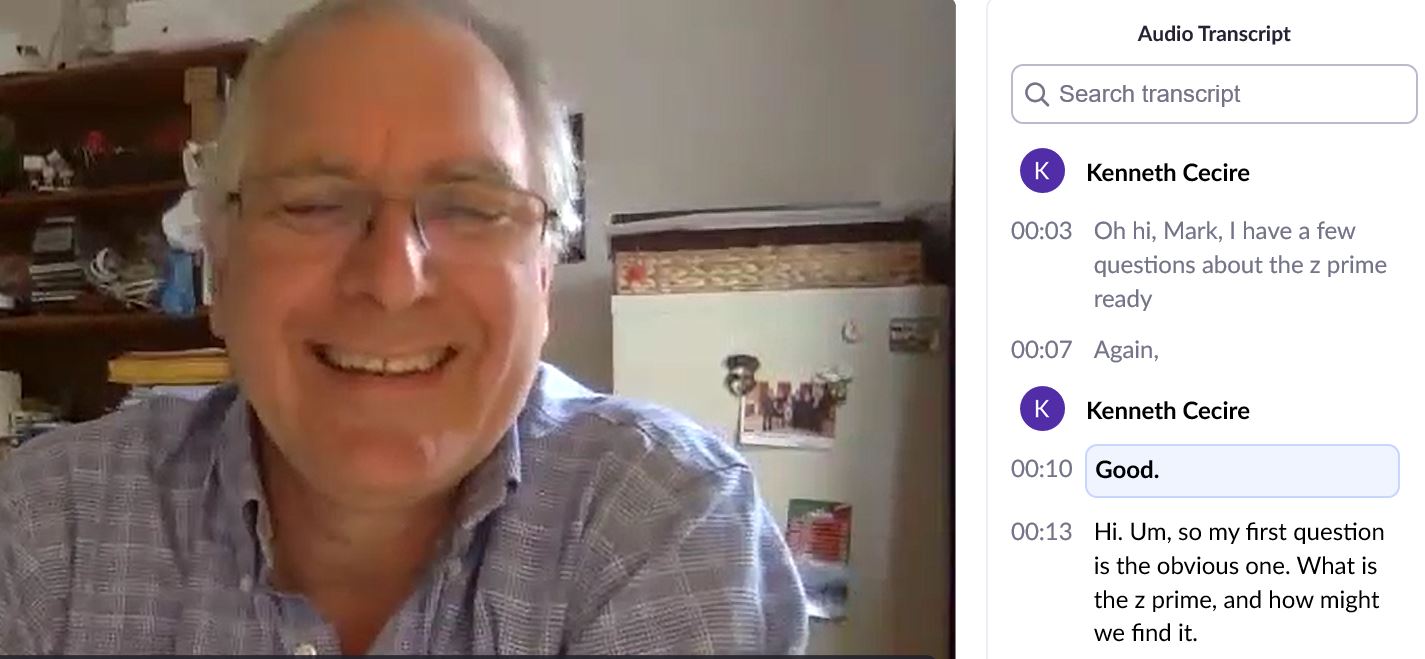Friday Flyer - May 1, 2020

Spotlight on a Prime, if Hypothetical, Boson
If you have worked with International Masterclasses or the CMS e-Lab, you are probably familiar with the Z boson, that neutral particle that decays into opposite-charge pairs of particles. In most of our work in QuarkNet, we look at the two most prominent lepton decays: electron-positron and muon-antimuon. It can also decay into the more exotic tau and antitau or into quark-antiquark pairs, which form jets. (Learn about jets in Fermilab News.)
Physicists have hypothesized the Z' particle as an extension of the Standard Model (read: new physics!) that decays like the Z but is much more massive. (It sort of looks like a duck, waddles like a duck, and quacks like a duck, but is something more than a duck.) The Z has a mass of about 91 GeV, but the Z' might be in the TeV (103 GeV) range. And as it turns out, one of the physicists who has been researching the Z' is our own Mark Adams. Mark chatted with Ken about it yesterday; take a look and a listen to learn more about this mysterious particle by choosing the image or caption just below.

News from QuarkNet Central
Happy May! QuarkNet starts this month with two offerings to assist teachers working remotely with students.
What's new? QW2 is new! QuarkNet Wednesday Webinars (QW2) will provide interactive presentations on topics in particle and contemporary physics on five of the six Wednesdays between May 6 and June 10. This should be a great chance for your students to learn some physics at home and engage with physics experts. Go ahead and register your students and yourself for the first webinar, History of Neutrinos by Rick Dower, on the QW2 page.
Hold it: one thing about QW2. Why five out of six weeks? Why the bye? Well, this month we are doing another round of the Big Analysis of Muons in CMS (BAMC) and its CMS Physics presentation will be given on Tuesday, May 19. So rather than hold a competing talk on Wednesday, we figure the students can learn about CMS on Tuesday.
But hold it! Another round of BAMC? There is still a chance to join? You bet, and it takes place after the last AP Physics exam, so it is a perfect time for those students to transition to some exciting, cutting-edge physics analysis. Learn more about BAMC at the Teacher Launch page, which includes a registration link to be filled out by teachers.
Reminder: Mentors and teachers at each QuarkNet center will decide whether and how they can meet this summer. Also, centers may want us to retool QuarkNet National Workshops such as Neutrino Data Workshop for remote online participation. If your center needs to change plans, postpone the workshop, or move it online, or has any request that might help, please let Spencer, Shane, or Ken know. We can work it out.
Thinking about the AAPT 2020 Summer Meeting in Grand Rapids? Well, it has has been changed to a virtual meeting. For more information about this recent announcement, check out the AAPT 2020 Summer Meeting website.

Physics Experiment Roundup
The LHC may be shut down for maintenance and upgrades and most physicists may be working from home, but LHC physics has not stopped. In symmetry, we learn about what happens when proton-proton collisions become boson-boson collisions. And CERN Bulletin reports that ATLAS and CMS are studying Higgs-top interactions to learn about matter-antimatter asymmetry.
As for the rest of experimental physics, well, it is hopping too. In neutrino world, Fermilab News tells us about the liquid-argon time projection chambers that will be the "eyes" of DUNE and explains momentum conservation in MINERvA that is reminiscent of the MINERvA Neutrino Masterclass. Not stopping, they go on to explain magnets in accelerators. And in a blast from the past for veterans of the MARIACHI project at the BNL-SB QuarkNet center, Physics Today discusses using radar to detect cosmic rays.

Resources
APS Physics gives us two articles on the culture of physics: one about the venerable (and hugely important) Physical Review D and another on, well, smartphones. More on the physics education side of things, TRIUMF provides a nice video and social media resources page while AAPT provides a virtual coffee hour and share-a-thon for members this coming Tuesday.

Just for Fun
Congratulations, Fermilab! It's a bison!
Let's celebrate with music videos: some neutrino music and a lab safety concert.
Yes, xkcd.
QuarkNet Staff:
Mark Adams: adams@fnal.gov
Ken Cecire: kcecire@nd.edu
Spencer Pasero: spasero@fnal.gov
Shane Wood: swood5@nd.edu

